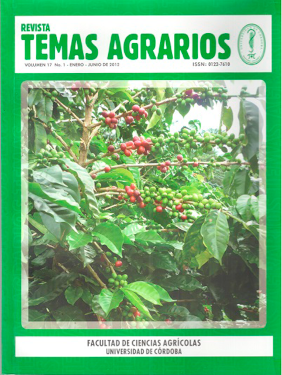Comparison of atmospheric and vacuum frying in obtaining snack of mango (Manguifera indica L.)
Comparación de la fritura al vacío y atmosférica en la obtención de pasabocas de mango (Manguifera indica L.)

This work is licensed under a Creative Commons Attribution-NonCommercial 4.0 International License.
Show authors biography
Sensory characteristics (texture, aroma, color and taste) of mango snacks obtained at atmospheric pressure and vacuum were evaluated by a semi-trained panel. Content of vitamin C and acrylamide, were determined by VISIBLE-UV. The process conditions were: atmospheric pressure, 175ºC of temperature and 30s; 110ºC under vacuum and 90s of immersion time. Results shows that the loss of vitamin C under vacuum (43,2%) was less than half of which is lost to atmospheric pressure (93,8%) and reduced the production of acrylamide, was reduced in 83,4% under vacuum. The sensory characteristics showed a significant difference in color and flavor being better qualified the vacuum frying, although no difference to the aroma and texture. These results agreed with the values of the physic-chemical characteristics: fat reduction, moisture content and breaking force in 52,8%, 48,8% and 38,6% respectively. It was concluded that vacuum frying generates better physicchemical, sensory and nutritional characteristics than the atmospheric pressure process.
Article visits 1097 | PDF visits
Downloads
- Agronet. 2011. CORPOICA identifica los mejores mangos criollos para mercado interno y exportación. Ministerio de Agricultura y desarrollo rural, www. agronet.gov.co [13 julio 2011].
- AOAC Official Methods of Analysis. 1980. Método oficial 20.013. Humedad en plantas. Métodos oficiales de análisis AOAC. Internacional.
- Apinya, E., Tipvanna, N. y Ray, J. W. 2006. Comparing sensory methods for the optimisation of mango gel snacks. Food Quality and Preference 17(8):622-628.
- Becalski, A., Lau, B., Lewis, D. y Seaman, S. 2003. Acrylamide in foods: occurrence, sources, and modeling. Journal of Agricultural and Food Chemistry 51(3):802-808.
- Bernal, I. 1998. Análisis de Alimentos. Colección Julio Carrisoza Valenzuela No. 2. Tercera edición. Bogotá, p114- 116.
- Bouchon, P., Aguilera, J., y Pyle, D. 2003. Structure oil-absorption relationships during deep-fat frying. Journal of Food Science 68(9):2711-2716.
- Corzo, O., Bracho, N. y Álvarez, C. 2008. Water effective diffusion coefficient of mango slices at different maturity stages during air drying. Journal of Food Engineering 87(4):479-484.
- Coughlin, J. 2003. Acrylamide: what we have learned so far. Food Technology 57(2):100.
- Da Silva, P. y Moreira, R. 2008. Vacuum frying of high-quality fruit and vegetable-based snacks. Food Science and Technology 41(10):1758-1767.
- Fillion, L., y Henry, C. 1998. Nutrient losses and gains during frying. International Journal of Food Sciences and Nutrition 49(2):157-168.
- Granda, C., Moreira, R. y Tichy, S. 2004. Reduction of acrylamide formation in Potato chips by low-temperature vacuum frying. Journal of Food Science 69(8):405-411.
- Han, J., Kozukue, N., Young, K., Lee, K. y Friedman, M. 2004. Distribution of ascorbic acid in potato tubers and in home-processed and commercial potato foods. Journal of Agricultural and Food Chemistry 52(21):6516-6521.
- Krumbein, A. y Auerswald, H. 2000. Aroma volatiles in tomato varietiesinstrumental, sniffing and quantitative descriptive analysis. In: Schieberle P, Engel KH, editors. Frontiers of flavor science. Garching, Germany: Deutsche Forschungsanstalt für Lebensmittelchemie. p 51-55.
- Langourieux, S., Perren, R. y Escher, F. 2000. Influence of processing parameters on the aroma of dry-roasted hazelnuts. In: Schieberle P, Engel KH, editors. Frontiers of flavor science. Garching, Germany: Deutsche Forschungsanstalt für Lebensmittelchemie. p 527-535.
- Mir-Bel, J., Oria, R. y Salvador, M. 2009. Influence of the vacuum break conditions on oil uptake during potato post-frying cooling. Journal of Food Engineering. 95(3):416-422.
- Mottram, D. y Wedzicha, B. 2002. Acrylamide is formed in the Maillard reaction. Nature 419(6906):448449.
- Pedreschi, F., Kaack, K. y Gramby, K. 2004. Reduction of acrylamide formation in potatoes slices during frying. LWT – Food Science and Tecnology 37(6):679-685.
- Rosen, J. y Hellenäs, K. 2002. Analysis of acrylamide in cooked foods by liquid chromatography tandem mass spectrometry. Analyst 127(7):880-882.
- Shyu, S. y Hwang, L. 2001. Effects of processing conditions on the quality of vacuum fried apple chips. Food Research International 34(2-3):133-142.
- Stadler, R., Blank, I., Varga, N., Robert, F., Hau, J. y Guy, A. 2002. Acrylamide from Maillard reaction products. Nature 419:449-450.
- Tareke, E., Rydberg, P., Karlsson, P., Eriksson, S. y Tornqvist, M. 2002. Analysis of acrylamide, a carcinogen formed in heated food - stuffs. Journal of Agricultural and Food Chemistry, 51(17):4998-5006.
- Troncoso, E., Pedreschi, F. y Zúñiga, R. 2009. Comparative study of physical and sensory properties of pre-treated potato slices during vacuum and atmospheric frying. Lebensmittel-Wissenchaft und-Technologies-Food Science and Technology 42(1):187-195.
- Villamizar R. y Giraldo G. 2010. Obtención y caracterización de un pasabocas a partir de una pasta a base de mango mediante fritura por inmersión. Revista Tumbaga 1(5):149-164.
- Villamizar R. 2011. Elaboración de un pasaboca de mango Tommy Atkins (Manguifera indica L.) por el método de fritura por inmersión. Tesis de Magister en Química Universidad del Quindío. Armenia.
- Weisshaar, R., y Gutsche, B. 2002. Formation of acrylamide in heated potato products – model experiments pointing to asparagines as precursor. Deutsche Lebensmittel-Rundschau 98:397-400.
- Wittig de Penna, E. 2001. Evaluación Sensorial Una metodología actual para tecnología de alimentos. Edición Digital reproducida con autorización del autor. Biblioteca digital de la Universidad de Chile.http://mazinger.sisib.uchile.cl/ repositorio/lb/ciencias_químicas_y_ farmaceuticas/wittinge01/index.html [10 noviembre 2010].
- Yagua, C. y Moreira, R. 2011. Physical and Thermal properties of potato chips during vacuum frying. Journal of Food Engineering 104(2):272-283.
- Zyzak, D., Sanders, R., Stojanovic, M., Tallmadge, D., Ebehart, L. y Ewald, D. 2003. Acrylamide formation mechanism in heated foods. Journal of Agricultural and Food Chemistry, 51:4782-4787




















